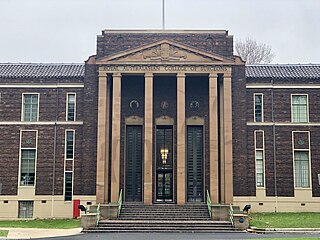In the medical profession, a general practitioner (GP) or family physician is a physician who treats acute and chronic illnesses and provides preventive care and health education to patients of all ages. GPs' duties are not confined to specific fields of medicine, and they have particular skills in treating people with multiple health issues. They are trained to treat patients to levels of complexity that vary between countries. The term "primary care physician" is more usually used in the US.

The Australian Medical Association (AMA) is an Australian public company by guarantee formed as a professional association for Australian doctors and medical students. The association is not run by the Australian Government and does not regulate or certify doctors, a responsibility which lies with the Medical Board of Australia and the Australian Health Practitioner Regulation Agency. The association's national headquarters are located in Barton, Australian Capital Territory, in addition to the offices of its branches in each of the states and territories in Australia.

Family medicine is a medical specialty within primary care that provides continuing and comprehensive health care for the individual and family across all ages, genders, diseases, and parts of the body. The specialist, who is usually a primary care physician, is named a family physician. It is often referred to as general practice and a practitioner as a general practitioner. Historically, their role was once performed by any doctor with qualifications from a medical school and who works in the community. However, since the 1950s, family medicine / general practice has become a specialty in its own right, with specific training requirements tailored to each country. The names of the specialty emphasize its holistic nature and/or its roots in the family. It is based on knowledge of the patient in the context of the family and the community, focusing on disease prevention and health promotion. According to the World Organization of Family Doctors (WONCA), the aim of family medicine is "promoting personal, comprehensive and continuing care for the individual in the context of the family and the community". The issues of values underlying this practice are usually known as primary care ethics.
A medical specialty is a branch of medical practice that is focused on a defined group of patients, diseases, skills, or philosophy. Examples include those branches of medicine that deal exclusively with children (paediatrics), cancer (oncology), laboratory medicine (pathology), or primary care. After completing medical school or other basic training, physicians or surgeons and other clinicians usually further their medical education in a specific specialty of medicine by completing a multiple-year residency to become a specialist.

Medical education in Australia includes the educational activities involved in the initial and ongoing training of Medical Practitioners. In Australia, medical education begins in Medical School; upon graduation it is followed by a period of pre-vocational training including Internship and Residency; thereafter, enrolment into a specialist-vocational training program as a Registrar eventually leads to fellowship qualification and recognition as a fully qualified Specialist Medical Practitioner. Medical education in Australia is facilitated by Medical Schools and the Medical Specialty Colleges, and is regulated by the Australian Medical Council (AMC) and Australian Health Practitioner Regulation Agency (AHPRA) of which includes the Medical Board of Australia where medical practitioners are registered nationally.
A specialist registrar (SpR) is a doctor in the United Kingdom or the Republic of Ireland who is receiving advanced training in a specialist field of medicine in order to become a consultant in that specialty.

The Royal College of General Practitioners (RCGP) is the professional body for general (medical) practitioners in the United Kingdom. The RCGP represents and supports GPs on key issues including licensing, education, training, research and clinical standards. It is the largest of the medical royal colleges, with over 50,000 members. The RCGP was founded in 1952 in London, England and is a registered charity. Its motto is Cum Scientia Caritas – "Compassion [empowered] with Knowledge."
The Royal Australasian College of Physicians (RACP) is a not-for-profit professional organisation responsible for training and educating physicians and paediatricians across Australia and New Zealand.

The Royal Australasian College of Surgeons (RACS) is the leading advocate for surgical standards, professionalism and surgical education in Australia and New Zealand.
Fellow of the Royal Australasian College of Physicians, abbreviated as the post-nominal initials FRACP, is a recognition of the completion of the prescribed postgraduate specialist training programme in internal adult or internal paediatric medicine of the Royal Australasian College of Physicians.
The Postgraduate Medical Education and Training Board was the non-departmental public body responsible for postgraduate medical education and training in the United Kingdom (UK). The General Medical Council (GMC) took over the functions of PMETB on 1 April 2010 when the two organisations merged.
The Australian College of Rural and Remote Medicine (ACRRM) is one of the two Australian Medical Council (AMC) accredited general practice colleges in Australia. The College sets and upholds standards for best practice provision of rural and remote medical care. It provides training and certification, and professional development for rural general practice. It also provides advocacy and support for current and prospective rural doctors.
Dr Sue Page AM is a past President of the Rural Doctors Association of Australia and current Board member of Future Health Leaders, North Coast GP Training, and RACGP Rural As Associate Professor with the University of Sydney she links to the Northern Rivers University Centre for Rural Health, a collaboration between that university and the University of Southern Cross for the delivery of multidisciplinary health professional education in Australia. Until 2010 she was the inaugural Director of the North Coast Medical Education Collaboration, a venture linking the University of Sydney, the University of Western Sydney and the University of Wollongong which established year-long training for medical students in rural areas and later combined with the UCRH.
The Royal New Zealand College Of General Practitioners is a professional body and postgraduate educational institute that sets standards for general practice in New Zealand, providing research, assessment, ongoing education, advocacy and support for general practitioners and general practice.

The Royal Australian and New Zealand College of Obstetricians and Gynaecologists (RANZCOG) is a not-for-profit organisation dedicated to the establishment of high standards of practice in obstetrics and gynaecology and women’s health. The College has a strong focus on women's health advocacy and trains and accredits doctors throughout Australia and New Zealand in the specialties of obstetrics and gynaecology. Its head office is in Melbourne, Australia. It was founded in 1998, with the amalgamation of the Australian and New Zealand organisations. As of 2018, the College had 2,211 Fellows in Australia and New Zealand; 277 subspecialists, and 2,549 Diplomates.
Phlebology is a medical speciality that is concerned with venous issues including the diagnosis and treatment of disorders of the veins. A medical specialist in this field is known as a phlebologist. The specialty of phlebology has developed to enable physicians sharing an interest in venous disease and health to share knowledge and experience despite being trained in a variety of backgrounds such as dermatology, vascular surgery, haematology, interventional radiology or general medicine. Diagnostic techniques used include the patient's history and physical examination, venous imaging techniques in particular vascular ultrasound and laboratory evaluation related to venous thromboembolism. The American Medical Association and the American Osteopathic Association have added phlebology to their list of self-designated practice specialties.

The Royal Australian and New Zealand College of Psychiatrists (RANZCP) is the principal organisation representing the medical specialty of psychiatry in Australia and New Zealand and has responsibility for training, examining and awarding the qualification of Fellowship of the College (FRANZCP) to medical practitioners.
Michael Richard Kidd AM is an Australian medical practitioner, academic and author. He is a past president of the Royal Australian College of General Practitioners (RACGP) and a past president of the World Organization of Family Doctors (WONCA).
Dr Eugen Molodysky OAM, MMBS is an academic and medical practitioner in preventive medicine and translational research. His research has been published in peer reviewed journals over the last 30 years. He has a life-long professional focus on prevention, preclinical diagnosis and early intervention.

The Australasian College of Sport and Exercise Physicians (ACSEP) is a not-for-profit professional organisation responsible for training, educating, and representing over 350 doctors in Australia and New Zealand. These doctors practise medicine in the specialty of sport and exercise medicine (SEM). The ACSEP is the smallest of the 15 recognised specialist medical Colleges in Australia with approximately 260 Fellows and Registrars in 2020.








